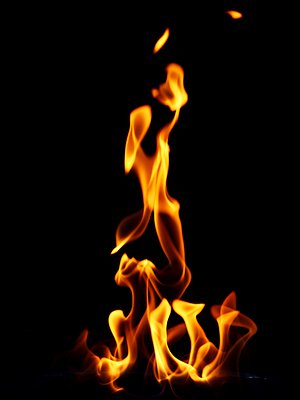
Author: БАКИРОВ ДАМИР РОБЕРТОВИЧ / BAKIROV DAMIR ROBERTOVICH
Introduction
The relevance of the chosen topic is determined by the fact that the harm from fires, as well as explosions of the oil and gas industry has a large scale, as well as a tendency of continuous growth. It has catastrophic consequences for the environment and loss of life. Thus, the issue of researching new ways of extinguishing a fire for various classes of substances remains relevant. A new method of extinguishing fire, a method based on the influence of an electric field on charged particles in the flame is proposed.
Chemoionization process
The flame is formed as a result of physical and chemical processes during gorenje. The surface layer in which the oxidation reaction occurs is called the flame front. It is in the flame front that exothermic oxidation reactions occur and ions are formed.
For the first time, the manifestation of charged particles in the flame was discovered by A. Volta. He determined that bodies with an electrostatic charge can be discharged upon contact with a flame.
The maximum saturation of ions in the reaction zone decreases rapidly with the end of the chemical reaction. Undoubtedly, ions do not arise due to thermal collisions, but rather due to changes in chemical processes in the interaction zone. However, ions arise in a significant excess compared to the number predicted from chemical equilibrium. Consequently, they are formed as a result of a certain non-equilibrium process called chemoionization.
The principle of the new extinguishing method
Knowledge of the electrical structure of the flame opens up the possibility of effective control of gorenje characteristics with the help of electric fields and the creation of promising technologies on this basis.
Thus, an electric field with a strength of, for example, 1-3 kV / cm created by two electrodes affects charged particles (ions and electrons) and forces them to move to the electrodes themselves. These charged particles, in turn, have a great influence on the gas flows in the flame, as a result of which the redox reaction of the flame will stop and the flame will go out.
For a more effective extinguishing of the flame of hydrocarbons by an electric field, it is required to calculate their quenching intensity. Knowing the physico-chemical properties of the substances under study, the total charge of ions in the specified volumes of the substance is calculated, and then the quenching intensity is calculated from the results obtained.
Prediction of physical and chemical properties of substances
In such cases, a method for predicting physico-chemical properties is proposed, based on the search for a quantitative structure-property ratio.
All the physical and chemical properties of a molecule are encoded in its structure. The definition of quantitative structure-property relations makes it possible to effectively understand these properties. This allows us to understand how the composition of the compound affects its reactivity. To find the relationship between the structure and the property, different methods of mathematical modeling are used. The choice of these methods depends on the nature of the compound under study and the nature of the analysis. A special role among these methods is occupied by topological methods that use exclusively the data contained in the structural composition of the compounds under study. One of the most important topological indicators for predicting physicochemical properties is the Wiener index and its own topological indicators. An example of the calculation is shown below.
Construction of the adjacency matrix for butane:
C4H10
An undirected graph of the form is constructed:
G = (V = {1,2,3,4}, E = {(1,2), (1,3), (1,4) (2,1), (2,3), (2,4) (3,1), (3,2), (3,4), (4,1) (4,2), (4,3)})
G = (V = {1,2,3,4}, E = {(0,1,0,0), (1,0,1,0), (0,1,0,1), (0,0,1,0)})
From vertex 1, you can get to other vertices by the shortest paths:
|
vertex |
1 |
2 |
3 |
4 |
|
1 |
0 |
1 |
2 |
3 |
|
2 |
1 |
0 |
1 |
2 |
|
3 |
2 |
1 |
0 |
1 |
|
4 |
3 |
2 |
1 |
0 |
Adjacency matrix:
Thus, the Wiener index will be equal to:
Based on the Wiener index and the eigenvalues of the topological matrix (TM), a linear two-parameter model of the form is compiled
where Z is the calculated physicochemical property of the hydrocarbon,
,
,
– coefficients of the model (have dimension properties),
W is the Wiener index (dimensionless value),
λ is the square of the eigenvalues of TM (a dimensionless quantity).
The coefficients to which can be known physico-chemical properties of hydrocarbons (for example, M is the molar mass, Tvsp is the flash point and Tsamovospl is the self–ignition temperature. Using this model, unknown physicochemical properties of a substance can be determined based on its structure (W, λ) and known properties.
Conclusion
Thus, using this method of extinguishing, in the future it is possible to significantly reduce the number of accidents occurring in the oil and gas industry, and as a result reduce the risk of fatal injuries.
And the method of predicting the physico-chemical properties of substances can greatly simplify research in the field of applied chemistry and design, because the search for the necessary physico-chemical properties of substances, compounds and petroleum fractions is 10-20% of the total design costs.